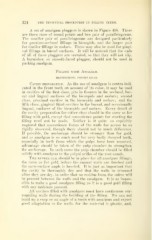Page 660 - My FlipBook
P. 660
324 THE TECHNICAL PROCEDURES IN FILLING TEETH.
A set of amalgam pluggers is shown in Figure 410. There
are three sizes of round points and two pair of parallelograms.
The smaller pair of parallelograms are desigTied particularly
for proximo-occlusal fillings in bicuspids, and the larger pair
for similar fillings in molars. These may also be used for gingi-
val fillings in buccal surfaces. It will be noticed that the ends
of all of these pluggers are serrated, so that they will not slip.
A burnisher, or smooth-faced plugger, should not be used in
packing amalgam.
Filling with Amalgam.
ILLUSTRATIONS: FIGURES 411418.
Cavity preparation. As the use of amalgam is contra -indi-
cated in the front teeth on accoimt of its color, it may be used
in cavities of the first class, jjits in fissures in the occlusal, buc-
cal and lingual surfaces of the bicuspids and molars; second
class, proximal cavities in the bicuspids and molars; and the
fifth class, gingival third cavities in the buccal, and occasionally
lingual, surfaces of the bicuspids and molars. Every detail of
the cavity preparation for either class should be the same as for
filling with gold, except that convenience points for starting the
filling need not be made. Neither is it quite so explicitly
required that convenience forms of the walls for access be so
rigidly observed, though there should not be much ditference.
If possible, the anchorage should be stronger than for gold,
and as amalgam is so much used for very badly decayed teeth,
especially in teeth from which the pulps have been removed,
advantage should be taken of the pulp chamber to strengthen
the anchorage. In such cases the pulji chamber should be filled
solidly witli amalgam to the pulpal orifice of the root canals.
The rubber dam should be in place for all amalgam fillings,
the same as for gold, before the enamel walls are finished and
the cavo-surface angle is beveled. It is just as important that
the cavity be thoroughly dry and that the walls be trimmed
after they are dry, in order that no residue from the saliva will
be present between the walls and the amalgam. It is as impos-
sible to make a good amalgam filling as it is a good gold filling
with any moisture present.
All cavities filled with amalgam must have continuous sur-
rounding walls during the building of the filling. We can not
build up a cusp or an angle of a tooth with nmalgani and expect
good adaptation to the walls, for the material is plastic, and,


